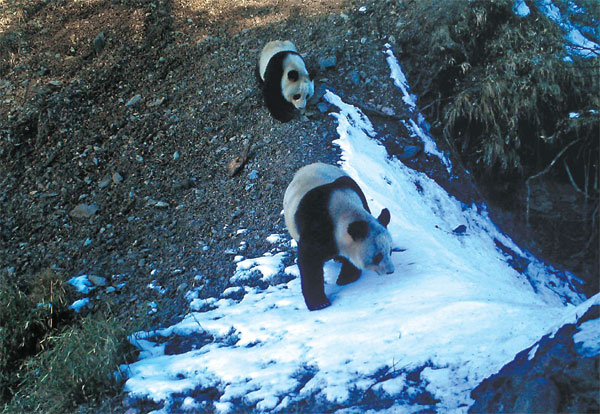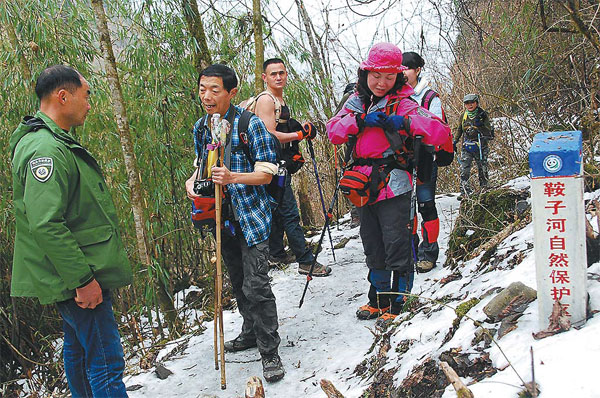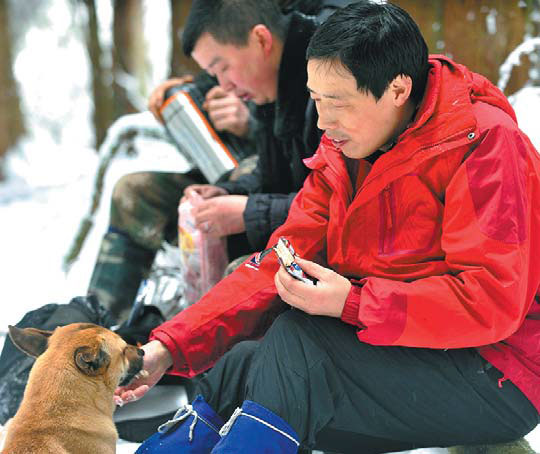Tourists put panda 'love corridor' under threat
Updated: 2015-04-17 07:03
By Huang Zhiling in Chengdu and Peng Yining in Beijing(China Daily Europe)
|
|||||||||||
Hikers are disrupting the animal's movement along a vital passage between nature reserves
Wildlife watchers and hikers are posing a risk to a vital passageway used by giant pandas in China's southwest to find partners during mating season, conservationists have warned.
Dubbed "the love corridor" by park rangers, the forests of Anzihe Nature Reserve in Sichuan province link two major habitats for the endangered animals.
|
A panda and her cub wander in the Anzihe Nature Reserve in Sichuan province in 2012. The reserve is a passageway used by wild pandas to travel between two habitats and find partners during mating season. Provided to China Daily |
|
A nature reserve worker (left) tries to persuade tourists not to enter the reserve as their presence might disturb pandas using the passageway. Wang Lei / For China Daily |
However, an increasing number of tourists sneaking into the area, which is closed to the public, mean the wild pandas are being scared away from the route, putting further strain on efforts to get the animals to reproduce.
"We're seeing more people and less pandas," says ranger Fu Qiang, who has worked at the reserve for six years. "The corridor might be blocked if people continue to stream in."
Anzihe, which is in the northwest corner of Chongzhou city, was set up in 1993 and is a major panda habitat. More importantly, it is a link between the world-famous Wolong National Nature Reserve, in Wenchuan county, and Dayi county's Heishuihe Nature Reserve, and is used as a passageway by male and female pandas in mating season.
Cameras to monitor the animals' movements are strategically placed among the trees. Fu says it is not uncommon for them to capture touching scenes such as those released by the park in 2013, when footage showed a female panda and her frolicking cub navigating a steep slope.
Yet the 34-year-old ranger says it was now more common for the cameras to record tourists wandering the forests.
He recalls that, during a patrol on one icy morning in February, he and his colleagues encountered a group of six hikers. "Anzihe is very close to a public forest park, and there is no fence between," he says. "I told the hikers not to go any further into the reserve, and pointed out that the boundary tablet was right beside them."
Later that day, his team came across a group of 20 people, all with hiking canes and climbing equipment.
"One man pushed me. The path is only 1 meter wide, and I almost fell down the slope," Fu says. "They all got through. We couldn't stop them. One of them said they just wanted a hike in the reserve and wouldn't cause any harm. But they don't realize that their hike has a negative influence on the pandas and other wild animals."
That was just one of many conflicts Fu had with tourists, and the frequency is growing.
In turn, park rangers have noticed a reduction in the traces of wild panda activity on the reserve's border. Evidence suggests most of the animals have retreated to the core area to avoid invading sightseers.
Off limits
Since 1998, workers at Anzihe have recorded more than 1,500 traces of panda activity, leading to estimates that the area is home at least eight pandas, according to Wang Lei, deputy director of the reserve's management office.
A report released in February by the State Forestry Administration of China put the number of wild pandas at 1,864, with another 375 living in captivity.
Out of the nation's nature reserves, Anzihe has the highest panda population density, with a habitat stretching 99.42 square kilometers, roughly 98 percent of the park's total area.
In recent years, the reserve's infrared cameras have captured wild pandas more than 10 times, including the mother panda and her cub, and a panda marking a tree. Staff members have also rescued and treated two sick pandas.
Anzihe is the only viable route for wild pandas to travel between Wolong reserve, home to 143 pandas, and the Heishuihe reserve, which has 21. Other parts of the two reserves are blocked by rivers and cliffs.
Yet the spot is also popular with hikers, as it is 70 km from downtown Chengdu, the provincial capital.
Wang says national nature reserves prohibit any human activity within core areas, while the outer areas are used as buffer zones and should be accessed only for the purposes of scientific research, which is tightly controlled by forestry administrations.
Tourists are strictly banned from entering all areas, but they continue to sneak in, he says. The nine Anzihe park ranges find it almost impossible to stop them, whether they are in large groups or individuals, because of the large, unfenced area they need to cover.
Confrontations with tourists have led to attacks on staff members, Wang says, adding that there are no regulations or laws to punish hikers found on the reserve.
"People may think they are just visiting a park, but once they step foot on that prohibited land they are harming the wildlife," he says. "When the environment in Anzihe is affected, the breeding grounds and general habitat of the pandas and other endangered animals in the two adjoining reserves are influenced too."
Hou Rong, director of the Chengdu Research Base of Giant Panda Breeding, echoed his warning, adding that when humans invade, wild animals are scared away.
Her center has helped to breed many pandas as well as trained them for survival in the wild, but she says pandas can potentially migrate great distances after they are released.
"We've traced our pandas kilometers away from where we released them," she says. "It's very likely they will notice a lot of human activity and will feel unsafe. For wild animals, long-distance migration holds a high risk of death."
Danger zones
According to data from the State Forestry Administration in February, China's wild pandas are spread among 33 groups, many of which have a population of less than 30. Twenty-four groups, including 223 pandas, are at "considerable" risk of disappearing, while 18 groups have less than 10 pandas and face a "high" risk.
"For small groups, the love corridor is their only chance to find a partner and survive," Hou says. "If the corridor is taken over by people, the pandas will disappear in a few years."
It is not just wildlife the tourists are affecting. They also leave piles of garbage and potential fire hazards in their wake, according to Liu Yong, another park ranger at Anzihe Nature Reserve.
He says two groups of about 30 hikers in February left plastic bags and empty containers for instant noodles strewn along the forest floor. "We had to clean up all their garbage in the snow and at altitudes of up to 2,000 meters."
Hikers in prohibited areas are also putting their own lives at risk.
In July, four people had to call the police after getting lost in the reserve. A rescue team of more than 10 people, including eight park rangers, searched for nine hours until the group was found at 3 am.
And last month, a 44-year-old woman fell down a slope while hiking with a group of 38 people. She suffered severe injuries to her eyes and lungs, and it took 29 people 22 hours to save her.
Rescuers says she had been lucky, as a boulder had prevented her plummeting 40 meters into a valley below.
"We find that many hikers get lost in the woods, or fall or hurt themselves some other way," Liu says. "For the safety of the pandas, the other wild animals and people, we just can't let tourists in."
Contact the writers at huangzhiling@chinadaily.com.cn and pengyining@chinadaily.com.cn
|
Ranger Fu Qiang feeds a dog during a lunch break in a routine inspection in the Anzihe Nature Reserve. Lyu Jia / For China Daily |
(China Daily European Weekly 04/17/2015 page24)
Today's Top News
AIIB to operate in 'transparent way'
PLA to buy advanced missiles from Russia
EU accuses Google of hurting consumers, competitors
Q1 economic data: what the economists say
Holocaust memories to live on
Problem-plagued Milan Expo battles a long list of headaches
Foreign ministers call for end to fighting in east Ukraine
Spotlight set to shine on royal sibling
Hot Topics
Lunar probe , China growth forecasts, Emission rules get tougher, China seen through 'colored lens', International board,
Editor's Picks

|

|

|

|

|

|









